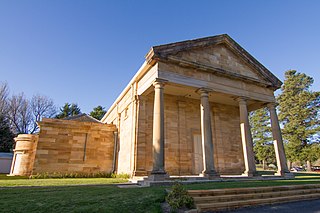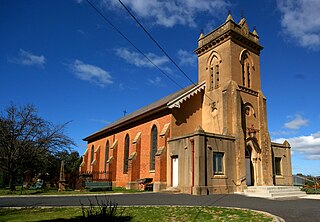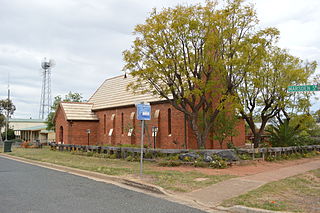
Berrima is a historic village in the Southern Highlands of New South Wales, Australia, in Wingecarribee Shire. The village, once a major town, is located on the Old Hume Highway between Sydney and Canberra. It was previously known officially as the Town of Berrima. It is close to the three major towns of the Southern Highlands: Mittagong, Bowral and Moss Vale.

Moss Vale is a town in the Southern Highlands of New South Wales, Australia, in the Wingecarribee Shire. It is located on the Illawarra Highway, which connects to Wollongong and the Illawarra coast via Macquarie Pass.

The St Saviour's Cathedral is the heritage-listed cathedral church of the Anglican Diocese of Canberra and Goulburn in Goulburn, Goulburn Mulwaree Council, New South Wales, Australia. The cathedral is dedicated to Jesus, in his title of Saviour. The current dean is the Very Reverend Phillip Saunders. It was added to the New South Wales State Heritage Register on 20 April 2009.
Bowral is a town in the Southern Highlands of New South Wales, Australia. It has a history spanning nearly 200 years.

The St John's Anglican Church, officially known as the Church of St. John the Evangelist, is a heritage-listed active Anglican church located at 120 Darlinghurst Road in the Sydney suburb of Darlinghurst, New South Wales, Australia. The church and its associated buildings were added to the New South Wales State Heritage Register on 2 April 1999. It was also listed on the former Register of the National Estate.

The Garrison Church is a heritage-listed active Anglican church building located at Argyle Street in the inner city Sydney suburb of Millers Point in the City of Sydney local government area of New South Wales, Australia. It was designed by Henry Ginn, Edmund Blacket and built from 1840 to 1846 by Edward Flood and George Patton. It is also known as Holy Trinity Anglican Church and Hall. The property is owned by Anglican Church Property Trust and was added to the New South Wales State Heritage Register on 2 April 1999.

St Michael's Cathedral is a heritage-listed Anglican cathedral at Church Street, Wollongong, City of Wollongong, New South Wales, Australia. It is the principal Anglican church in the city of Wollongong and the mother-church of the Bishop of Wollongong. It was designed by Edmund Blacket and built from 1858 to 1859. The property is owned by the Anglican Church Property Trust. It was added to the New South Wales State Heritage Register on 2 April 1999.

Holy Trinity Anglican Church is a heritage-listed Anglican church precinct, containing the church, rectory and adjacent cemetery, at 71-85 Gilmour Street, Kelso, Bathurst Region, New South Wales, Australia. The church was built from 1833 to 1878, with John Foster being responsible for the building of the original church. Edmund Blacket designed the rectory. The property is owned by Anglican Property Trust Diocese of Bathurst and Parish of Kelso, Anglican Diocese of Bathurst. It was added to the New South Wales State Heritage Register on 14 January 2011.

St Mary's Anglican Church is a heritage-listed Anglican church and associated facilities located at 240 Birrell Street, Waverley, in the Waverley Municipality, Sydney, New South Wales, Australia. The church was designed by Edmund Blacket and built between 1863 and 1864. It is very well known and sought after as a place to be married and is popular for funerals. The building is also notable due its pipe organ, designed and built by August Gern. The property is used for ministry by the Anglican Parish of Bondi and Waverley, which is an amalgamation of two previous Parishes ; The first Rector of St Mary’s Waverley, Rev Stanley Mitchell, was a keen Evangelical and although he used traditional Anglican liturgy was “low church” like most of Sydney Diocese. However there has been a long history of more “High” Anglicanism and Anglo Catholic theological underpinnings. Since 2014, the church has returned to a strongly evangelical base while running a very strong traditional 1662 prayer book communion service every Sunday. It also has less traditional al services to accommodate more contemporary congregations.

The All Saints' Anglican Church is a heritage-listed Anglican church located at McDonnell Street, Condobolin in the Lachlan Shire local government area of New South Wales, Australia. The church was possibly designed by Edmund Blacket and was built from 1878 to 1879 by Mr Brinsmead. It is also known as All Saints Anglican Parish Church. The property is owned by the Anglican Diocese of Bathurst. It was added to the New South Wales State Heritage Register on 2 May 2008.
White Horse Inn is a heritage-listed former residence, inn, bank and restaurant at Market Street, Berrima, Wingecarribee Shire, New South Wales, Australia. It was built from 1834 to 1850 by Edward Davies. It is also known as Commercial Bank of Australia, Rosebank, Oldbury's Inn, Holsberry Inn, Mail Coach Inn, and Royal Mail Coach Inn. It was added to the New South Wales State Heritage Register on 2 April 1999.

St Francis Xavier's Roman Catholic Church is a heritage-listed Catholic church at Hume Highway, Berrima, Wingecarribee Shire, New South Wales, Australia. It was designed by Augustus Pugin and built from 1849 to 1851 by William Munro. Originally known as St. Scholastica's Church, it is used by the Parish of St. Paul, administered by the Pauline Fathers, and located in the Diocese of Wollongong. It was added to the New South Wales State Heritage Register on 25 January 2008.

Berrima Post Office is a heritage-listed post office at Argyle Street, Berrima, Wingecarribee Shire, New South Wales, Australia. It was built in 1886 by R. N. Matthews. It was added to the New South Wales State Heritage Register on 2 April 1999.
Berrima Inn is a heritage-listed residence and former inn, cafe, craft shop and restaurant at Jellore Street, Berrima, Wingecarribee Shire, New South Wales, Australia. It was built by Brian McMahon. It is also known as McMahon's Inn. It was added to the New South Wales State Heritage Register on 2 April 1999.

Christ Church is a heritage-listed Anglican church located on Bong Bong Road, Bong Bong, in the Wingecarribee Shire local government area of New South Wales, Australia. It was built in 1845 at the behest of Charles Throsby, possibly by convict labour. The design of the church has been attributed to John Verge. The church site includes an associated cemetery. It was added to the New South Wales State Heritage Register on 7 April 2000.

St Stephen's Anglican Church is a heritage-listed Anglican church and cemetery at 187–189 Church Street, Newtown, Inner West Council, Sydney New South Wales, Australia. It was designed by Edmund Blacket and built from 1871 to 1874 by George Dowling and Robert Kirkham. The church is also known as St Stephen's Church Of England. It was added to the New South Wales State Heritage Register on 2 April 1999.

St John's Anglican Church and Macquarie Schoolhouse is a heritage-listed Anglican church building and church hall located at 43-43a Macquarie Road, Wilberforce, City of Hawkesbury, New South Wales, Australia. The church was designed by Edmund Blacket and built from 1819 to 1859 by James Atkinson, senior; and the schoolhouse was built by John Brabyn. The church is also known as the St. John's (Blacket) Church, while the hall is also known as the Macquarie Schoolhouse/Chapel and the Wilberforce Schoolhouse. It was added to the New South Wales State Heritage Register on 20 August 2010.

The Cathedral of the Annunciation of Our Lady is a heritage-listed former Anglican church and now Greek Orthodox cathedral located at 242 Cleveland Street, Redfern, City of Sydney, New South Wales, Australia. The church was designed by Edmund Blacket and the rectory was designed by John Burcham Clamp and built from 1848. It is also known as the Greek Orthodox Cathedral; St Paul's Anglican Church; St Pauls Church of England; Cathedral of the Annunciation of Our Lady Theotokos. The property is owned by Greek Orthodox Archdiocese of Australia. It was added to the New South Wales State Heritage Register on 17 April 2012.

St Peter's Anglican Church is a heritage-listed Anglican church and associated Sunday school, rectory, and cemetery at 384 Windsor Street, Richmond, City of Hawkesbury, New South Wales, Australia. It was designed by Francis Clarke and Edmund Blacket and built from 1836 to 1841 by James Atkinson (church). It is also known as St Peter's Anglican Church Group, St Peter's Church Group, Church, Rectory, Church Yard, Cemetery and Stables. It was added to the New South Wales State Heritage Register on 16 August 2019; and on the City of Hawkesbury local government heritage register, and listed on the New South Wales Heritage Database on 12 September 2012.
The Church of the Holy Innocents is a heritage-listed Anglican church at 130 Rossmore Avenue West, Rossmore, City of Liverpool, New South Wales, Australia. It was designed by Richard Cromwell Carpenter and Edmund Blacket and built from 1848 to 1850 by William Munro. The property is owned by Anglican Church Property Trust Diocese of Sydney. It was added to the New South Wales State Heritage Register on 24 August 2018.

















